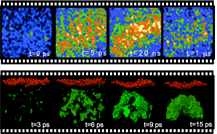What Is PULSE?Our mission is cutting-edge research in ultrafast science. PULSE, a partnership between SLAC, Stanford and the U.S. Department of Energy, provides a central home and world leadership in ultrafast and short wavelength science and technology. One of the primary tools of PULSE is the Linac Coherent Light Source (LCLS) at SLAC, the world’s first hard X-ray free electron laser. The LCLS is about a billion times brighter than any X-ray source ever produced in the laboratory. PULSE science is motivated by the transformational research opportunities of ultrafast and high field science with X-rays. PULSE is developing science not possible before the LCLS. What is "ultrafast?"The motion of atoms inside molecules during a chemical transformation, or the atomic motion that accompanies a phase change from solid to liquid occurs very fast—on the order of one trillionth of a second, or a picosecond. The electrons that rearrange in bonds when light is absorbed or during a chemical transition can move more than one thousand times faster than that—on the order of a femtosecond or less. To capture, view, and probe this motion, we need to have laser pulses much shorter than one picosecond. What is "high field?"The environment inside a molecule or between atoms in a solid is characterized by very strong electric and magnetic fields over very short distances (Angstroms). High-field lasers can probe this energy scale by producing light fields with strength comparable to this atomic binding field, or many volts per Angstrom. What are X-rays?X-rays are a form of light with a very short wavelength. X-ray microscopes have a very high spatial resolution, capable of viewing individual atoms inside a molecule or in a solid. Why is the LCLS so special?Simply put, LCLS is the first tool in human history capable of producing light with a wavelength on the scale of atomic length, field strength, and time. For the first time we will be able to "see" quantum processes on the atomic scale. Our challenge is to make this happen. PULSE has five major research areas:
PULSE also provides education programs in ultrafast X-ray science through our summer school and new research programs through our visitors program and our seed funding program. The Stanford PULSE Institute is a research center within the Photon Science Directorate of SLAC, and is designated as a Stanford Independent Laboratory. Awards

Raw snapshots of the X-ray scattering from an optically-excited semiconductor near the ablation threshold as a function of time.

|